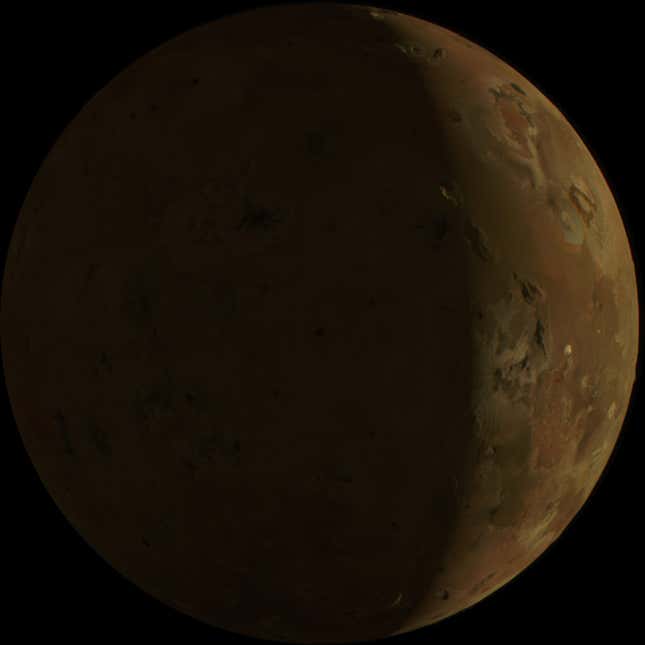NASA’s Juno spacecraft captured new images of Jupiter’s moon Io during its latest flyby, coming within an eerily close distance of the most volcanically active world in the solar system for a second time in less than two months. The close encounter also shows what appears to be a pair of plumes erupting from the moon’s surface.
On Saturday, Juno made the second closest flyby of Io, traveling at a distance of 930 miles (1,500 kilometers) away from the moon. During its rendezvous, the spacecraft got a clear view of Io’s chaotic terrain, revealing some of the hundreds of volcanoes and molten silicate lava that plague its surface.
The raw images are made available by NASA, primed and ready for the processing pleasure of visual designers and space enthusiasts on the internet. A closeup view of one of the images may also reveal the eruption of two plumes from Io’s surface, “emitted either by two vents from one giant volcano, or two volcanoes near each other,” according to the Southwest Research Institute. The team behind the Juno mission is still analyzing the data gathered by this week’s flyby to better understand what exactly is happening in the image.
NASA’s Juno spacecraft, which has been studying the Jovian system since 2016, recently turned its attention to Jupiter’s third largest moon. Juno observed Io during previous flybys in May and July 2023 and captured a cozy family photo of Jupiter and Io in September 2023, revealing the gas giant and its moon side by side.
On December 30, the Jupiter probe got its first close look at Io, flying at a distance of 930 miles (1,500 kilometers) away from its hellish surface. This marked the closest flyby of Jupiter’s moon, not just by Juno but by any spacecraft, in 20 years. The closeup images revealed the mutilated surface of Io in great detail, which gets its signature orange hue from the sulfur erupting from its volcanoes.

As the innermost of Jupiter’s four Galilean moons, Io is stuck between the planet’s immense gravitational force and the gravitational tug of its sister moons Europa and Ganymede. This contributes to the moon’s volcanic activity as Io is constantly being stretched and squeezed due to its position. The surface of Io is mangled by hundreds of volcanoes and lakes of molten silicate lava that appear as burnt scarring across its tortured landscape.
Scientists are using the pair of close flybys to to find out whether Io is harboring a magma ocean underneath its crust, according to NASA. The Juno science team will study how often the volcanoes on Io erupt, how bright and hot they are, and how the shape of the lava flow changes. A group of scientists from the Southwest Research Institute, which is located in San Antonio, Texas, will also study how Io’s volcanic activity is connected to the flow of charged particles in Jupiter’s magnetosphere by combining Juno data with remote observations by the Hubble and Webb space telescopes.
Juno is scheduled for another flyby of Io on September 20, carefully approaching the turbulent world for a third close encounter.
For more spaceflight in your life, follow us on X (formerly Twitter) and bookmark Gizmodo’s dedicated Spaceflight page.
Trending Products















